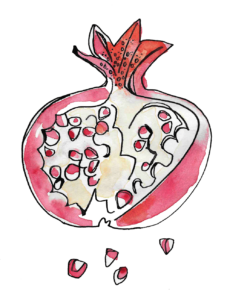by Derek Bromley
Hail, Caesar! Or should I say Cesare? Creamy, cheesy, with a little acid/spice kick and a healthy dose of umami, the Caesar salad delivers one of the most popular flavor combinations of the past century.
It was actually the first salad I got my kids to eat, enjoy and even request for dinner. Paired with its relative ease of preparation, its popularity with kids makes the Caesar a go-to recipe for harried parents trying to come up with healthy weeknight dinners.
Given the plethora of beautiful winter greens at the Napa Farmers Market right now, it’s a great time to add this simple dish to your repertoire. Romaine is classic in a Caesar salad, but chard and kale are abundant now and can substitute for romaine, so you can vary the recipe and keep the family interested.
But first, a little history. Many people think that this salad is named after Julius. After all, it’s Italian. (At least it’s on every Italian restaurant menu everywhere.) It contains anchovies and raw egg, so it must be an old recipe because what modern chef would put such controversial ingredients in a dressing?
Then I heard that the dish had Mexican origins. Huh? With no chiles or cilantro or queso fresco, how could this dish possibly be Mexican?
Here’s the real story. Caesar salad is generally attributed to Caesar (Cesare) Cardini, an Italian-born restaurateur who emigrated to the U.S. and opened restaurants in California and, later, in Tijuana in the early 1920s. His restaurant catered to Hollywood elites who crossed the border to escape the restrictions of Prohibition. Tijuana in those days was sort of like Las Vegas, an adult playground where the booze flowed freely even though it was illegal just across the border in the U.S.
There are a few different versions of the salad’s origin story. Some say that the restaurant was overrun with diners on the Fourth of July in 1924 and the desperate owner threw together the ingredients he had on hand, tossing them table-side for added flair. Other versions attribute the recipe to former restaurant employees, relatives or partners of Cardini.
What is certain is that Caesar salad rocketed Cardini’s restaurant to fame before spreading like wildfire across the States and eventually the world. In 1953, Paris’s International Society of Epicures named the Caesar salad the greatest recipe to originate in the Americas in the previous 50 years.
So what makes a great Caesar? First and foremost: ingredients. This is a simple preparation, with nowhere for a less-than-stellar ingredient to hide. Second: balance. The key to this recipe is the tension created by just the right proportions of creamy (egg, oil), zippy (lemon), spicy (garlic, pepper, Dijon mustard) and umami (Worcestershire, anchovy, Parmigiano Reggiano). The difference between meh and extraordinary comes down to understanding and balancing this tension.
My recipe includes a few nontraditional methods, all geared toward making it easier to get your dressing into the “nirvana zone” of balance. First is to add lemon zest, which contributes some brightness. Second is to marinate the garlic, pepper and lemon zest in the lemon juice for a few minutes, which mellows the garlic. Lastly, adding a dollop of Dijon mustard makes it easier to get a good emulsion and helps integrate all the flavors.
Kids Activities at the Napa Farmers Market: Bring your youngsters to the market’s Education Station on Saturday, Jan. 26, for Story Time at 10:30 a.m.
On the KVYN Music Stage: Kendall Osbourne will perform at the Napa Farmers Market on Saturday, Jan. 26.
Winter Greens Caesar Salad
You can find organic eggs from pasture-raised chickens at the Napa Farmers Market. Any leftover dressing will keep for several days in the refrigerator.
1 clove garlic, pressed with a garlic press
Grated zest and juice of ½ lemon
1/2 teaspoon salt
1/4 teaspoon freshly ground black pepper
1 egg yolk, preferably organic
1 teaspoon Dijon mustard
1/2 teaspoon Worcestershire sauce
1/4 teaspoon anchovy paste
1 cup extra virgin olive oil
1/4 cup grated Parmigiano Reggiano cheese, plus more for garnish
6 to 12 leaves of kale or chard, ribs removed
In a small bowl, combine the garlic, lemon zest, lemon juice, salt and pepper.
Put the egg yolk in a small mixing bowl. Add the mustard, Worcestershire sauce and anchovy paste and whisk together until smooth. Whisk in the lemon juice mixture.
Whisk in the olive oil, drop by drop at first, eventually building up to a steady stream when you are sure you have an emulsion. Taste the dressing for balance. Add a bit more oil if the dressing is too acidic. Add the cheese, taste, and adjust salt and pepper if necessary.
Slice the greens crosswise into fine ribbons. Toss with just enough dressing to coat the leaves (you may not need it all), garnish with additional cheese, and serve immediately.
Serves 2 to 4
Derek Bromley is the owner of Ohm Coffee Roasters (www.ohmcoffee.com) and a Napa Farmers Market board member.
The Napa Farmers Market takes place on Saturdays from 8:30 a.m. to 1 p.m., in the parking lot of the South Napa Century Center, 195 Gasser Drive, Napa. For more information or a schedule of upcoming events, visit www.napafarmersmarket.org.

